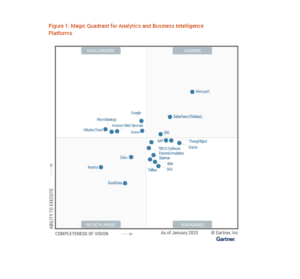While the addition of AI-powered insights to analytics and business intelligence (ABI) tools is certainly still occurring, a bigger trend currently is the addition of low-code and no-code automation capabilities to ABI tools, Gartner says in its recent Magic Quadrant report on the space.
“Many platforms are adding capabilities for users to easily compose low-code or no-code automation workflows and applications,” Gartner analysts Kurt Schlegel, Julian Sun, and others write in the latest Magic Quadrant for Analytics and Business Intelligence Platforms, which was published April 5.
“This blend of capabilities is helping to expand the vision for analytics beyond simply delivering datasets and presenting dashboards,” they continue. “Today’s ABI platforms can deliver enriched contextualized insights, refocus attention on decision-making processes and ultimately take actions that will deliver business value.”
The need for better governance of reports, dashboards, and other products of ABI tools is another trend that the sharps at Gartner are tracking. That translates into a renewed demand for building analytics catalogs into the products, which can make it easier for customers to track the thousands of reports they’ve developed.
A third major trend is market demand for a “headless, open architecture.” Gartner says a headless ABI platform would “decouple the metrics store from the front-end presentation layer, enabling more interoperability with competitive products.”
Gartner fleshed out their ABI platform criteria with three new categories: metrics store, collaboration, and data science integration.
The addition of the metric store is important, Gartner says, because it helps to re-center the ABI platform’s role in “defining and communicating performance measures throughout an organization,” as opposed to being “a glorified chart wizard.”
The addition of a collaboration category is important because it measures how well an ABI user can share their insights with others via tools like Slack (owned by Salesforce) or Teams (owned by Microsoft).
ABI products and data science and machine learning tools have been on a collision course for a while, Gartner. With the addition of a data science integration category, Gartner now has a method to track the ease with which an ABI user can, for instance, pop over to a data science tool to test a hypothesis, for example. Similarly, the integration can work the other way, and let someone working in a data science or machine learning platform pop on over to an ABI tool to tap into data prep or data visualization capabilities, or other common ABI strong suits.
In terms of the rankings, there wasn’t much change from last year. Microsoft once again dominated the ABI proceedings with its super-popular Power BI offering. Gartner says that “well-above-average functionality and an ambitious product roadmap” is powering Power BI to “massive growth” (although the product’s “greatly reduced price” probably doesn’t hurt). Integration with Microsoft 365, Teams, and Synapse is also a strength. Concerns include governance, a limited open headless architecture, and a lack of deployment options (Azure is your only option).
Tableau, which is owned by Salesforce, came in second place in the Leader’s Quadrant. Gartner cited the company’s “massive community of visual analytic developer” as a core strength, as well as cloud and data warehouse agnosticism. Cautions include slower growth, a focus on Salesforce integration, and the company’s shift to a cloud-first or cloud-only delivery model.
Qlik is the third and final member of the Leader’s Quadrant in Gartner’s MQ for ABI. The analyst group cites Qlik’s comprehensive data and analytics capabilities, its no-code approach to integrating with business processes, and its flexible deployment model that supports cloud and on-prem, as well as its partnerships with the three major clouds and Databricks and Snowflake. However, that agnosticism hurts Qlik, in Gartner’s view, because it prevents the vendor from building a surrounding data or application ecosystem, giving the “cloud and business application megavendors” a competitive advantage.
The Challengers Quadrant saw a lot of action this year. Last year, only two vendors—Domo and Google (i.e. Looker) were in this category. This year, those two vendors are joined by three additions, including AWS (with QuickSight), Microstrategy, and Alibaba Cloud, all of which moved up from the Niche Players Quadrant thanks to an improved ability to execute.
We see a lot of repeat customers in the Visionaries Quadrant this year. IBM, Oracle, SAP, SAS, Sisense, Tellius, TIBCO Software, and ThoughtSpot all made repeat appearances this year, while Pyramid Analytics moved over (up) to the Visionaries Quadrant from the Niche Players Quadrant.
Meanwhile, the Niche Players Quadrant was rather empty, with just GoodData, Incorta, and Zoho landing here. Incorta and Zoho are repeat visitors, while embedded analytics specialist GoodData is new to the quadrant.
Related Items:
Which BI and Analytics Vendors Are Incorporating ChatGPT, and How
Augmented Analytics Is the New BI Battle Ground, Gartner Says
ML and BI Are Coming Together, Gartner Says
The post What’s Moving the Analytics and BI Tool Business Now appeared first on Datanami.



0 Commentaires